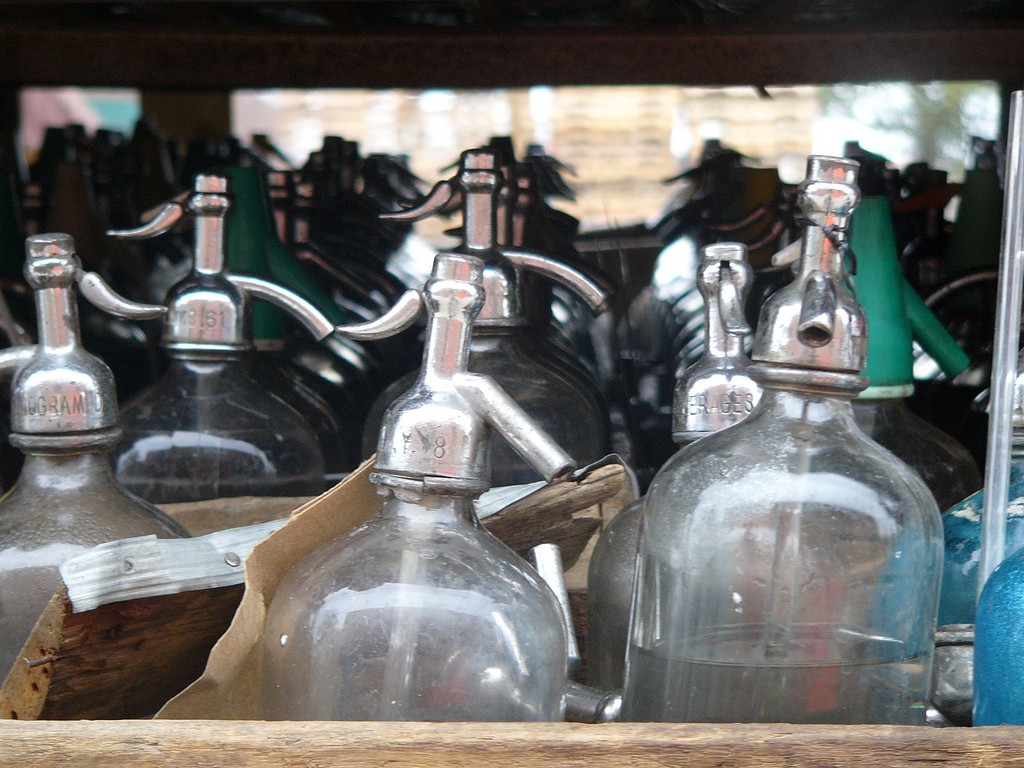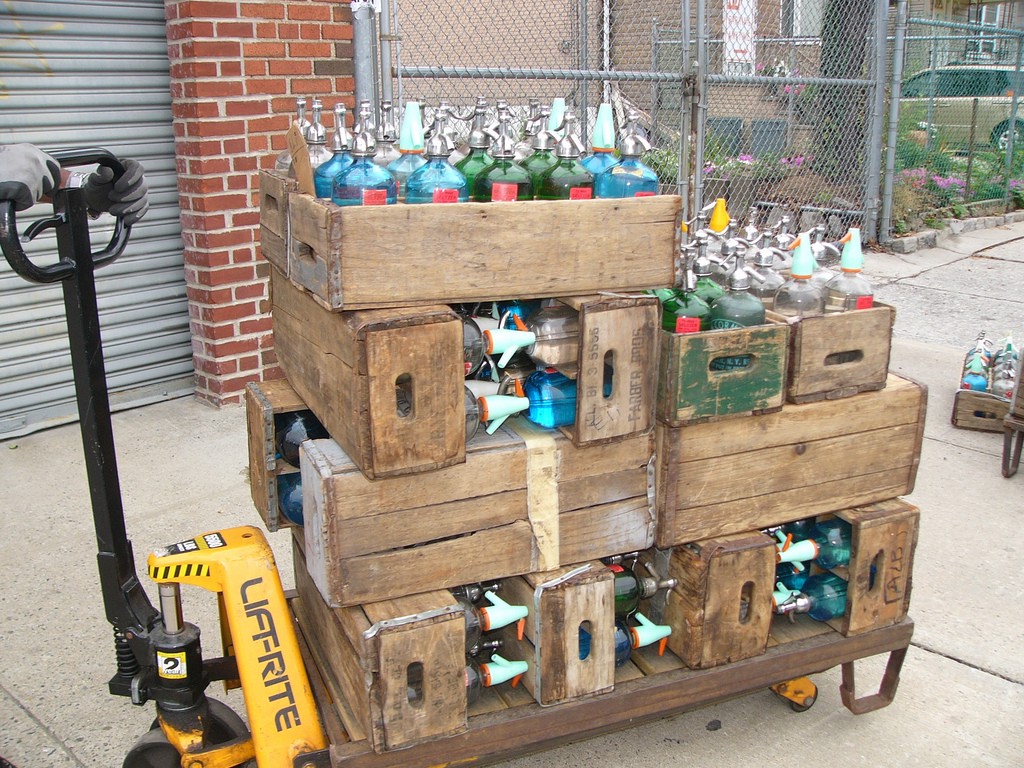Under Pressure
by Brendan O’Connor

One day at the end of August, dozens of cases of seltzer were piled in stacks that rose chest-high around a cramped warehouse in Canarsie, Brooklyn. Each case holds ten bottles of seltzer and weighs seventy pounds when the bottles are full. A small black cat slunk between the stacks. “That is Chicago,” Alex Gomberg, a twenty-seven-year-old, fourth-generation seltzer man, said. “If he bites you, I will chase him outta here.”
Alex’s great-grandfather, Mo Gomberg, a seltzer delivery man with his own route, had been filling up at a co-op in Brooklyn when he decided to open up his own shop, Gomberg Seltzer Works, on the corner of 92nd Street and Avenue D in 1953, so “he didn’t have to schlep it anymore,” Gomberg said. At the time, there were dozens of such filling stations in the city, hundreds of seltzer men, and thousands of customers receiving cases of seltzer at their homes every week. Mo passed the business to his son Pacey, and Pacey passed the business along to his son — Gomberg’s father — Kenny. Only two of Gomberg Seltzer Works’ four siphon machines, manufactured in London in 1910, are still operational, and only one is actually in use. “We’re the last fillers in all of New York,” Gomberg said. “People don’t know it, that it exists anymore.”
For a long time, seltzer was just a New York thing. Jewish immigrants brought a taste for seltzer — “the worker’s champagne,” as it was colloquially known — to the Lower East Side in the late nineteenth century. “In 1880 there were only two seltzer companies in New York,” writes historian Gerald Sorin in his book A Time for Building: The Third Migration, 1880–1920. “By 1907 over a hundred operated in the remarkable ethnic economy Jews had created.” When Canada Dry started marketing flavored seltzers around the country in the mid-eighties, “it found that few people outside the New York area even knew the word,” the New York Times reported in 1986. “The company had to include the phrase ‘sparkling water’ on packaging.”
Real seltzer is made like this: City tap water — commonly understood to be the reason for the quality of New York’s pizza and bagels, and which comes from a nearly two-thousand square-mile network of nineteen reservoirs and three “controlled” lakes that extend one-hundred-twenty-five miles north and west of the city — is triple-filtered through sand (to remove any solids), charcoal (to remove any odors or tastes), and then paper (to remove any remaining particles). Then it’s mixed with carbon dioxide in a very loud carbonator, where two beating paddles diffuse the gas into the liquid. Each bottle is placed into the machine upside down, by hand. Atop each is a head with a spout and a trigger mechanism. Inside the head, amongst a half a dozen other parts, is a valve — when the bottle is placed into the siphon machine, a lever presses a trigger on the side of the bottle’s head, which opens the valve, and the newly carbonated water is forced in. Each bottle, when it is full of seltzer, contains sixty pounds of pressure. Gomberg gestured with one. “If this thing falls down and explodes, you’re done. You’re gonna get hurt. It’s not pretty,” he said. “Sometimes you don’t see a crack in the bottle. We try to look at all the bottles and make sure, because if not?” He rolled his eyes and grimaced. “I should probably put mats down.”
The glass bottles, about three thousand in all, are a quarter-inch thick. The oldest were hand-blown in Czechoslovakia in the late nineteenth and early twentieth centuries, and some are engraved with the last names of the delivery men to whom they belonged. “When there were hundreds and hundred of seltzer men on the route, everyone had their own bottles,” Gomberg said. (Customers typically don’t own the bottles; they just pay for the service and the seltzer inside, exchanging empty bottles for freshly filled ones during each delivery.) Recently, Gomberg found bottles belonging to the fathers of two of his customers. “Abisher and Singer — both fathers were seltzer men,” Gomberg told me. “It says ‘Singer and son’ on one and ‘Abisher’ on the other. I sold the bottle to them, but they keep giving it back to me so I can fill it. So it’s not like I’m losing it. I’m still making money off it.” He paused. “You know, people thank me. I’m like, ‘You don’t have to thank me, I’m trying to make money!’ But they say, ‘Thank you for keeping the business alive.’”
Seltzer bottling hasn’t been profitable as a business for a long time, and it shrinks every year. People die, or move to Florida. Gomberg’s father Kenny makes his money as a beer and soda wholesaler, operating out of the other side of the warehouse; he’s kept the filler machines running as a favor to the guys still on the route. “Don’t take this the wrong way, but these guys are eighty years old,” Gomberg said, waving towards a stack of cases. “He’s not gonna be here forever. Who’s he passing his route to? Where do you think his customers are gonna go when they can’t find seltzer?” he laughed. “None of these guys have websites. They’re pen and paper. I’m the first seltzer man with an email address!”

Gomberg and his three siblings grew up in New City, New York, about an hour upstate from the city. “We had seltzer at the dinner table all the time.” Now he lives in Fort Lee, New Jersey, with his wife. She drinks about a case a week. “She mixes it with everything,” he said. “She loves it. That’s why she married me.” But growing up, he never expected to carry on his father’s business. “I don’t think anybody is going to wake up one day and say, ‘I want to be a seltzer man.’ Who wants to carry a seventy-freakin’-pound case up different sets of stairs every day?” he asked. After two years at Rockland County Community College, Gomberg transferred to UMass-Amherst, where he pursued an M.A. in higher-education administration and advised club sports teams. After graduating, he couldn’t find a job he liked in a place that he liked, so he decided to enter the family business.
Initially, Gomberg only wanted to open an egg-cream stand at the Barclays Center, but he found the process to become a vendor at the arena to be too bureaucratic. “It was too involved logistically, too much money,” he said. Instead, he started his own delivery route. “We had all these bottles just sitting here doing nothing. So I cleaned ’em up, restored ’em. Started pounding the pavement.” A case of Brooklyn Seltzer Boys’ seltzer costs thirty-five dollars per delivery, with a hundred-dollar deposit for the bottles — at least three or four times as much as store-bought seltzer. “It’s cheaper, for sure,” Gomberg said. “Doesn’t taste as good, but it’s cheaper.” Part of the reason that Gomberg’s seltzer tastes better is because it remains under pressure. The “bite” that you feel when you take a sip of a carbonated beverage — not the tickle of the bubbles, but the slight bit of sharpness in the back of your throat — is proportional to the amount of gas in the liquid, and these bottles, with their century-old nozzles, keep the pressure contained. “Good seltzer should hurt,” reads the back of Brooklyn Seltzer Boys’ t-shirts, a phrase borrowed from Gomberg’s father.
Seltzer consumption is increasing in the United States, for the first time in a long time. When sales rose by 16.3 percent in 2011, this was greater growth than any other product on the bottled water market, according to an industry report published at the time by the Beverage Marketing Corporation. In 2012, Forbes reported that sales rose by a further thirty-four percent. According to Forbes, seltzer — or, well, “sparkling water,” really — accounted for around ten percent of the $11.4 billion bottled water market in 2013. “This category is expected to swell in the coming years,” Forbes reported. “Consumers are likely to switch to the natural and healthier low calorie carbonated water in order to meet their beverage requirements.”
For now, though, Gomberg is focusing on marketing to restaurants and food festivals rather than individual customers. His biggest customer is The Arlington Club, a steakhouse in Manhattan to which he delivers twenty cases every week, and which charges fifteen dollars per bottle. “It’s a lot! They make good money. People like it, because they can’t get it anywhere else,” Gomberg said. “Well, they think they can’t get it anywhere else.” The bar that takes the most seltzer is Dutch Kills, in Long Island City — eight cases a week. “Most of the bars and restaurants, they just add it as a topper. It’s kinda more for show, spritzing,” he said. “It just looks cool.” He recently attended a Mitzvah Market — a kind of a showcase for vendors people might want to hire for their children’s bar and bat mitzvahs. In the spring though, he’ll finally be selling egg creams, at Smorgasburg in Dumbo, for five dollars a piece. (“Most Sundays, unless I have a bar mitzvah.”)
While there is no shortage of the water and carbon dioxide needed to make seltzer, there is a limit to how much Gomberg can bottle. The elaborate trigger mechanisms inside of the nozzles, which keep the seltzer carbonated, are no longer made — at least not at a price Gomberg can afford. He’s now working with a retired seltzer man who lives on Staten Island, a friend of the family who has a foundry in his garage, to design new molds for replacement parts. But it’s slow going. “The mechanics of a bottle are pretty simple, but it’s finicky. It’s new parts going into old parts, and the old parts are… old.”
Gomberg’s office is crowded with spare parts from bottles, broken bottles, fancy bottles, more ornate than those stacked outside. “I would like one year from now to exhaust all the bottles in this place. Just try to make a living just with the cases I have here,” he said. “In five years, I’m nationwide. Well, when I say ‘nationwide,’ I’m talking about having an egg cream kit, shipping a bottle of seltzer with their name on it, etched. One seltzer bottle with their name etched on it, a bottle of chocolate syrup, a glass — here, I’ll show you.” He pulled out a glass with several lines drawn across it, marking how much of each ingredient to add. “Brooklyn egg cream. Throw a spoon in there, chocolate syrup in there,” he said. “I want to be shipping these everywhere. I got tons.”
Throughout my visit to the seltzer shop, Gomberg wavered between the practical and the philosophical. He’s a fourth-generation seltzer man capitalizing on nostalgia to sell an upmarket version of a drink that otherwise costs next to nothing. There’s something a little bit forlorn about the whole operation. At one point Gomberg reached down to lift one of the cases from the stack at our feet and hoisted it aloft. “This is about bringing a product that’s dying. I mean, if I don’t do it…” he trailed off. “This is a seventy-pound case, resting on my shoulder. If I don’t do it, it’s gone. It’s gonna go.”
Photos by barrrry joseph (1, 2)
